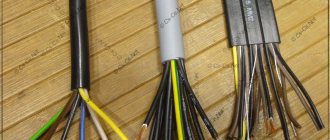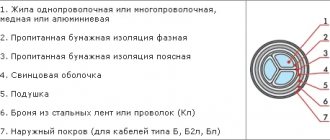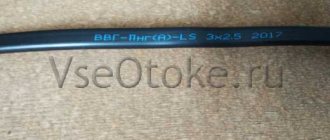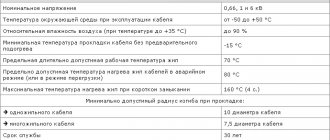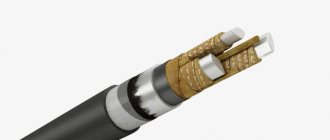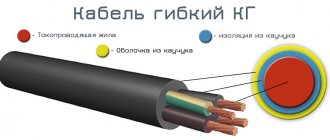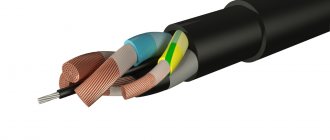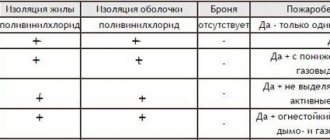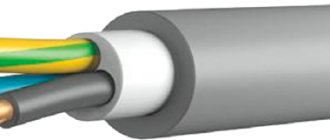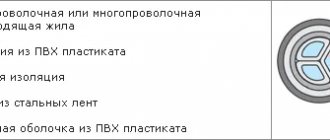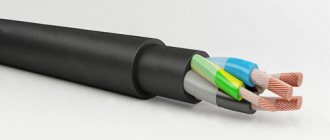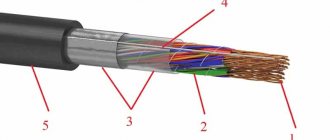Technical characteristics and service life
- AVVG cables are operated at ambient temperatures from minus 50 °C to plus 50 °C.
- The cables are operational at relative humidity up to 98% at temperatures up to 35 °C, according to GOST 15510-69.
- The electrical resistance of current-carrying conductors to direct current must comply with GOST 22483.
- Electrical insulation resistance of cores, 1 km length at a temperature of 20 °C, not less than:
- 10 MOhm, for conductors with a nominal cross-section of 2.5 - 4 mm2;
- 9 MOhm, for conductors with a nominal cross-section of 6 mm2;
- 7 MOhm, for conductors with a nominal cross-section of 10 – 240 mm2.
- AC test voltage with a frequency of 50 Hz for AVVG cables
Rated voltage, kV Test voltage, kV 0,66 3 1,0 3,5 - The warranty period for cables is 5 years from the date of commissioning.
- The service life of the AVVG cable is at least 30 years.
Main technical characteristics of cable VVG 5x6
We presented all the cable characteristics necessary for ordering and calculation in the form of a table.
| Characteristic name | Unit change | Meaning |
| GOST | — | GOST 31996-2012 |
| Core class according to GOST 22483-2012 | — | 1 |
| OKP code | — | 35 2122; 35 3371 |
| Fire hazard class | — | O1.8.2.5.4 |
| Operating temperature range | °C | -50 to 50 |
| Minimum installation temperature | °C | -15 |
| Duration of operation | years | 30 |
| Mains voltage | IN | up to 1000 |
| AC frequency in the network | Hz | 50 Hz |
| Allowable tensile force | N | 900 |
| Maximum permissible core heating temperature during short circuit | °C | 160 |
| Short circuit duration, no more | With | 5 |
| Estimated mass (weight) of the cable, 0.66 kV | kg/km | 462 |
| Estimated mass (weight) of one meter of cable, 0.66 kV | kg/m | 462/1000 |
| Estimated mass (weight) of cable, 1 kV | kg/km | 516 |
| Estimated mass (weight) of one meter of cable, 1 kV | kg/m | 516/1000 |
| Allowable bending radius | mm | 165 |
| Permissible current load when laying in air | A | 46 |
| Permissible current load when laying in the ground | A | 59 |
| Permissible one-second short circuit current | A | 0.65 |
| Volume of combustible mass | l/km | 227 |
| Core insulation resistance | MOhm/km | 9 |
| Core insulation thickness, 1 kV | mm | 1 |
| Core insulation thickness, 0.66 kV | mm | 0.7 |
| Mass of non-ferrous metal | g/m | 2.9 |
| Maximum power when installed in air, 220 V | kW | 13.49 |
| Maximum power when installed in the ground, 220 V | kW | 17.31 |
| Maximum power when installed in air, 380 V | kW | 30.27 |
| Maximum power when installed in the ground, 380 V | kW | 38.82 |
| Core heating temperature based on non-ignition conditions | °C | 350 |
| Long-term permissible core heating temperature | °C | 70 |
| Permissible temperature in overload mode | °C | 90 |
| Electrical resistance of the conductor | Ohm/km | 3.08 |
Expert opinion
Chief Editor of LinijaOpory
Alexander Novikov is the main author and inspirer of our site. Author of diagrams and drawings.
Before making calculations, we recommend that you additionally request cable characteristics from the manufacturer!
Operating instructions:
- Table of maximum voltages of electrical networks for which the AVVG cable is used:
Rated cable voltage, kV Maximum voltage of the three-phase network for which the cable is intended, kV 0,66 0,72 1,0 1,2 - AVVG cables must be used in accordance with the “Unified Technical Guidelines for the Selection and Use of Electrical Cables”.
- Cable laying must be carried out in accordance with the current “Electrical Installation Rules” (PUE) and technical documentation approved in the prescribed manner.
- It is allowed to lay cables without preheating at a temperature not lower than minus 15 °C.
- The minimum bending radius during installation must be at least 7.5 Dn for multi-core cables and at least 10 Dn for single-core cables (Dn is the outer diameter of the cable, mm.)
- The long-term permissible heating temperature of the cores during operation should not exceed 70 °C.
- The maximum permissible core temperature during a short circuit should not exceed 160 °C. The duration of the short circuit should not exceed 4 seconds.
- The permissible heating of cable cores in emergency mode should not exceed 80 °C. The duration of cable operation in emergency mode should not exceed 8 hours per day and 1000 hours over the entire service life of the cable.
- AVVG cables can be used in DC networks at voltage values 2.4 times higher than the voltage between the core and the screen or metal sheath.
- The electrical insulation resistance per 1 km of length, measured at the long-term permissible heating temperature of the cable cores during operation, must be at least 0.005 MOhm.
- Permissible current loads and permissible short-circuit currents must correspond to the table values:
Nominal core cross-section, mm2 Permissible current loads on cable AVVG, A Permissible one-second short circuit current of AVVG cables, kA Single-core Double-core Three-core On air In the ground On air In the ground On air In the ground 2,5 30 32 25 33 21 23 0,18 4 40 41 34 43 29 37 0,29 6 51 52 43 54 37 44 0,42 10 69 68 58 72 50 59 0,70 16 93 83 77 94 67 77 1,13 25 122 113 103 120 88 100 1,81 35 151 136 127 145 109 121 2,50 50 189 166 159 176 136 147 3,38 70 233 200 — — 167 178 4,95 95 284 237 — — 204 212 6,86 120 330 269 — — 236 241 8,66 150 380 305 — — 273 274 10,64 185 436 343 — — 313 308 13,37 240 515 396 — — 369 355 17,54
AVVG
Power cables / Catalog / Power cables / Power cables with plastic insulation / AVVG
Power cables with plastic insulation are intended for the transmission and distribution of electrical energy in stationary electrical installations at rated alternating voltages of 0.66, 1 kV and 3 kV.
1. Preferred area of application
Climatic modifications UHL and T, placement categories 1 and 5 according to GOST 15150-69. HL cables are intended for the transmission and distribution of electrical energy in stationary installations with a rated alternating voltage of 0.66; 1 rated frequency up to 100 Hz. Types of climatic modifications of cables HL, placement category 1, 2 and 5 according to GOST 15150.
2. Design
The conductor is aluminum or copper, single-wire or multi-wire.
The insulation is made of polyvinyl chloride plastic for cables of the brands AVVG, VVG, AVVGE, VVGE, AVVGng(A), VVGng(A), AVVGEng(A), VVGEng(A), AVBShv, VBShv, AVBShvng(A), VBShvng(A); for cables of brands APvVG, PvVG, APvVGE, PvVGE, APvVGng(A), PvVGng(A), APvVGEng(A), PvVGEng(A), APvBShv, PvBShv, APvBShvng(V), PvBShvng(V), APvBShp, PvBShp-iz silanol crosslinkable polyethylene.
The inner sheath of unarmored cables is made of polyvinyl chloride plastic compound or chalk-filled unvulcanized rubber mixture. In armored cables of brands VBShv, AVBShv, PvBShv and APvBShv - from polyvinyl chloride plastic compound, in cables of brands APvBShp and PvBShp - from polyvinyl chloride plastic compound or polyethylene, in cables of brands AVBShvng(A), VBShvng(A), APvBShvng(V), PvBShvng(V) ) – made of polyvinyl chloride plastic compound of reduced flammability.
The screen in shielded cables of the brands AVVGE, VVGE, AVVGEng(A), VVGEng(A), APvVGE, PvVGE, APvVGEng(A), PvVGEng(A) is made of copper tape or copper wires fastened with copper tape.
The sheath for cables of brands AVVG, VVG, AVVGE, VVGE, APvVG, PvVG, APvVGE, PvVGE is made of polyvinyl chloride plastic compound, in cables of brands AVVGng(A), VVGng(A), AVVGEng(A), VVGEng(A), APvVGng(A) ), PvVGng(A), APvVGEng(A), PvVGEng(A) - made of polyvinyl chloride plastic compound of reduced flammability.
The armor in armored cables of the brands AVBShv, VBShv, AVBShvng(A), VBShvng(A), APvBShv, PvBShv, APvBShvng(V), PvBShvng(V), APvBShp and PvBShp is made of flat galvanized steel strips.
The protective hose in armored cables of the brands AVBShv, VBShv, APvBShv, PvBShv is made of polyvinyl chloride plastic compound, in cables of the brands AVBShvng(A), VBShvng(A), APvBShvng(V), PvBShvng(V) - from polyvinyl chloride plastic compound of reduced flammability, in cables APvBShp and PvBShp brands – made of polyethylene.
The nominal cross-section of the cores is from 1.5 to 1000 mm2, depending on the cable brand, number of cores and rated voltage.
Cables are made with one, two, three, four or five cores. Multicore cables are manufactured with cores of equal cross-section. Four-core cables may have one conductor of a smaller cross-section. HL cables are manufactured with one-, two-, three-, four- and five-core cables for a rated voltage of 0.66 and 1 kV with a frequency of 50 Hz. The current-carrying conductors of five-core power cables of category HL must be single- or multi-wire.
3. Installation and operating instructions
The operating temperature limits of the environment are from minus 50 °C to plus 50 °C (except for cables with a protective polyethylene hose) and relative air humidity up to 98% at temperatures up to 35 °C.
Cables with a protective polyethylene hose are designed for operation at ambient temperatures from minus 60°C to plus 50°C.
Cables of the HL category are intended for operation at ambient temperatures from minus 60°С to plus 50°С, cables of all brands with the index “ng” - from minus 50°С to plus 50°С, cables of all brands with the index “ng-ХЛ” -60" and "mb" - from minus 60°C to plus 50°C.
4. Cable characteristics
4.1 Permissible current loads of cables with insulation made of polyvinyl chloride plastic compounds
| Nominal core cross-section, mm2 | Permissible current load of cables, A | |||||||||||
| Single-core | Stranded** | |||||||||||
| on direct current | on alternating current* | on alternating current* | ||||||||||
| with copper core | with aluminum core | with copper core | with aluminum core | with copper core | with aluminum core | |||||||
| on air | in the ground | on air | in the ground | on air | in the ground | on air | in the ground | on air | in the ground | on air | in the ground | |
| 1,5 | 29 | 41 | — | — | 22 | 30 | 21 | 27 | ||||
| 2,5 | 37 | 55 | 30 | 32 | 30 | 39 | 22 | 30 | 27 | 36 | 21 | 28 |
| 4 | 50 | 71 | 40 | 41 | 39 | 50 | 30 | 39 | 36 | 47 | 29 | 37 |
| 6 | 63 | 90 | 51 | 52 | 50 | 62 | 37 | 48 | 46 | 59 | 37 | 44 |
| 10 | 86 | 124 | 69 | 68 | 68 | 83 | 50 | 63 | 63 | 79 | 50 | 59 |
| 16 | 113 | 159 | 93 | 83 | 89 | 107 | 68 | 82 | 84 | 102 | 67 | 77 |
| 25 | 153 | 207 | 117 | 159 | 121 | 137 | 92 | 106 | 112 | 133 | 87 | 102 |
| 35 | 187 | 249 | 143 | 192 | 147 | 163 | 113 | 127 | 137 | 158 | 106 | 123 |
| 50 | 227 | 295 | 176 | 229 | 179 | 194 | 139 | 150 | 167 | 187 | 126 | 143 |
| 70 | 286 | 364 | 223 | 282 | 226 | 237 | 176 | 184 | 211 | 231 | 161 | 178 |
| 95 | 354 | 436 | 275 | 339 | 280 | 285 | 217 | 221 | 261 | 279 | 197 | 214 |
| 120 | 413 | 499 | 320 | 388 | 326 | 324 | 253 | 252 | 302 | 317 | 229 | 244 |
| 150 | 473 | 561 | 366 | 434 | 373 | 364 | 290 | 283 | 346 | 358 | 261 | 274 |
| 185 | 547 | 637 | 425 | 494 | 431 | 142 | 336 | 321 | 397 | 405 | 302 | 312 |
| 240 | 655 | 743 | 508 | 576 | 512 | 477 | 401 | 374 | 472 | 471 | 359 | 363 |
| 300 | 760 | 845 | 589 | 654 | 591 | 539 | 464 | 423 | 542 | 533 | 424 | 417 |
| 400 | 894 | 971 | 693 | 753 | 685 | 612 | 544 | 485 | 633 | 501 | 482 | |
| 500 | 1054 | 1121 | 819 | 870 | 792 | 690 | 636 | 556 | — | |||
| 625/630 | 1252 | 1299 | 971 | 1007 | 910 | 774 | 744 | 633 | — | |||
| 800 | 1481 | 1502 | 1146 | 1162 | 1030 | 856 | 858 | 713 | — | |||
| 1000 | 1718 | 1709 | 1334 | 1327 | 1143 | 933 | 972 | 793 | — | |||
4.2 Permissible heating temperatures of conductors
| Cable insulation material | Long-term permissible core heating temperature, °C | In overload mode | Limit at short circuit | According to the condition of non-ignition in case of short circuit |
| Polyvinyl chloride plastic compound | 70 | 90 | 160/140* | 350 |
| Cross-linked polyethylene | 90 | 130 | 250 | 400 |
*For cables with conductive cores with a cross-section of more than 300 mm
Application area
Cables of the VVGng brand are used for transmission and distribution of electric power with stationary installation at a rated alternating voltage of 0.66 kV and 1 kV frequency of 50 Hz.
VVGng cables are intended for use indoors, outdoors, electrical installations (ducts, pipes, trays, tunnels, etc.) in the absence of tensile loads on the cable.
VVGng cables are used in cases where increased fire safety is required to prevent the spread of combustion when laying cables in bundles. Corresponds to category A GOST 12176.
Characteristics
- Brand? Abbreviation (marking), as a rule, each capital letter has the meaning of a property or design. AVVG
- Number of cores? The power cable has from 1 to 5 cores. A cable with 1 core is used depending on the color of the core: g/h - grounding, blue (blue) - zero. white, red, black - phase colors. Cable with 2 cores used for zero and phase, 3 wires - zero, phase, 2
- Cross-section of the core (mm/sq)? Section or cut area, measured in square millimeters. The throughput of the core depends on the cross-section, in other words, how many amperes the core can carry. The larger the cross-section, the lower the resistance (Ohm). For voltage, the cross-section is 10
- Core material? Copper is the first most important core material, this is due to: 1) High electrical conductivity. 2) Sufficient mechanical strength. 3) Satisfactory corrosion resistance. Aluminum is the second most important core material according to the following points Aluminum
- Insulation material? PVC - polyvinyl chloride (the most common insulation material, with advantages: low fire hazard, relatively high durability in gentle conditions, with disadvantages: toxicity of combustion products.) HDPE - polyethylene (the most resistant to PVC
- Sheath material? Sheath (protective hose) - protects the insulation of the cores from external influences (mechanical, chemical, thermal, ultraviolet). PVC
- Maximum weight (kg/m)? Weight is an estimate, actual values may vary. 0.268
- Maximum outer diameter (mm) 14.8
- Electrical resistance of the core (ohm/km) 3.08
- Allowable bending radius (mm) 148
- Permissible current load when laying in air (A) 50
- Permissible current load when laying in the ground (A) 59
- Permissible one-second short circuit current (kA) 0.7
- Rated alternating voltage (kV) 1
- Operating temperature range (°C) from -50 to +50
- Service life 30
- OKP code 353 771
- Fire hazard class according to GOST 31565-2012 O1.8.2.5.4
- Volume of combustible mass (l/km) 211
- Core insulation resistance (MOhm/km) 7
- Core insulation thickness (mm) 1
- Weight of non-ferrous metal (g/m) 53.6
- Core design ok
- Maximum operating temperature (°C) 50
- Minimum operating temperature (°C) -50
- Maximum power when installed in air, 220V (kW) 14.67
- Maximum power when installed in the ground, 220V (kW) 18.48
- Maximum power when installed in air, 380V (kW) 32.9
- Maximum power when installed in the ground, 380V (kW) 41.45
- Type of execution according to GOST 31565-2012 Without designation
- GOST 31996-2012
- Core insulation thickness 0.66 Kv (mm) 0.9
- Core insulation color Gray, Blue
- Core class according to GOST 22483-2012 1
- Maximum core diameter 3.7
- Outer diameter 0.66 kV (mm) 14.4
- Estimated mass 0.66 kV (kg/km) 255
- Maximum design weight (kg/km) 268
- Long-term permissible core heating temperature 70
- Limit heating temperature of cores 160
- Heating temperature of the cores under the condition of non-ignition 350
- Allowable traction force (N) 1000
- Permissible temperature in overload mode 90
- Minimum installation temperature -15
- Minimum installation temperature -15
AVVG 2x10
- power cable with 2 aluminum cores with a cross-section of 10 square millimeters, insulated and sheathed from polyvinyl chloride plastic.
